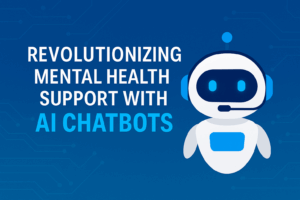Introduction: What You’ll Learn
In this blog, you’ll discover how AI chatbots are transforming mental health support through innovative applications of AI and cross-platform app development. We’ll explore the technologies behind mental health chatbots, their key features, real-world effectiveness, and future opportunities for startups and businesses.
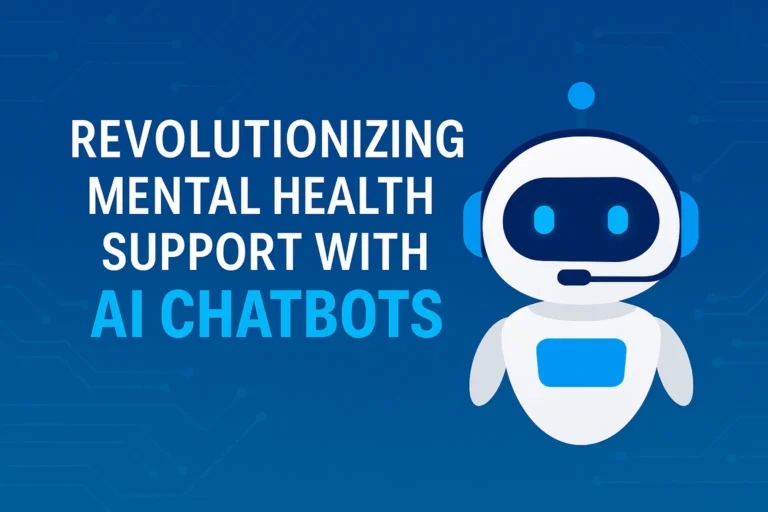
The Rise of AI Chatbots in Mental Health
AI chatbots have emerged as powerful digital health tools, offering mental health support through conversational AI, 24/7 availability, and scalable care delivery. They address systemic issues like the shortage of qualified therapists, high treatment costs, and stigma around mental health services.
Key drivers behind their adoption:
- Accessibility via smartphones
- Reduced stigma through anonymous interactions
- Scalability across global user bases
- Lower costs compared to traditional therapy
How Mental Health Chatbots Work
Core AI Technologies
-
Machine Learning (ML) and Deep Learning (DL)
Powers chatbot learning from user interactions to improve over time.
-
Natural Language Processing (NLP)
Enables understanding user intent, emotions, and context.
-
Generative AI and Large Language Models (LLMs)
Creates human-like, dynamic conversations, enhancing user engagement.
Interaction Mechanism
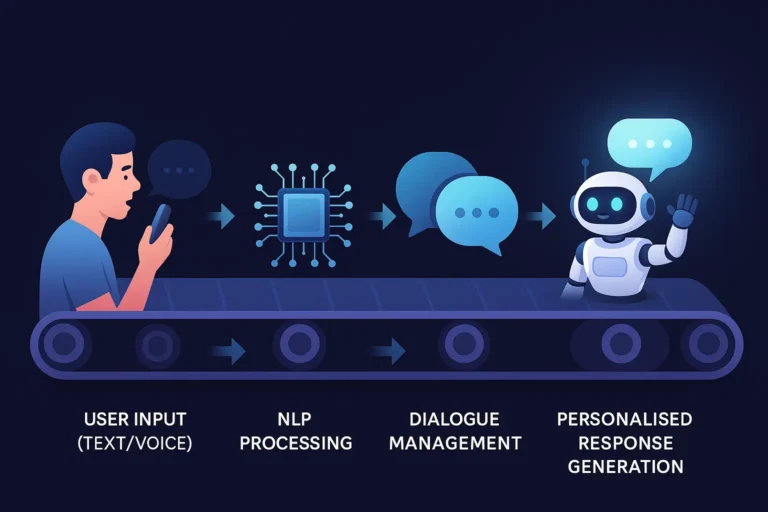
Types of Mental Health Chatbots
Rule-Based Chatbots
Rule-based chatbots follow predefined conversation paths based on keywords, menus, or decision trees. They are designed with strict controls, offering high predictability and safety, which is critical in mental health contexts where consistent, clinically validated messaging is vital.
While these bots can sometimes feel rigid, their structured nature ensures that users are guided through safe, carefully designed support pathways.
Example:
- Woebot: A widely recognised mental health chatbot, Woebot leverages rule-based systems to deliver Cognitive Behavioral Therapy (CBT) exercises, mood tracking, and psychoeducation while ensuring consistent, clinically sound interactions.
AI-Driven Chatbots
AI-driven chatbots use machine learning (ML) and natural language processing (NLP) to understand context and adapt flexibly to user conversations. Instead of simply matching keywords, these bots can analyse intent, emotions, and conversation history to generate more natural, human-like responses.
They may be retrieval-based (selecting the best-fit answer from a database) or generative (creating original responses in real time).
Example:
- Wysa: Combines AI with evidence-based therapeutic techniques like CBT and mindfulness, offering a highly personalised emotional support experience.
- Youper: Focuses on emotional health support, using AI to guide users through introspective conversations and mood tracking.
Therapeutic Chatbots
- Purpose: Deliver mental health interventions like CBT and mindfulness
- Clinical Validation: Often clinically tested and approved
- Examples: Woebot, Wysa
- Primary Audience: Users seeking mental health therapy or coping tools
- Safety Features: Crisis management and referral pathways included
- Conversation Style: Structured, goal-oriented, therapeutic guidance
Companion Chatbots
- Purpose: Offer emotional support and casual conversation
- Clinical Validation: Rarely clinically validated
- Examples: Replika, Character.AI
- Primary Audience: General users seeking interaction and connection
- Safety Features: Limited or no crisis support mechanisms
- Conversation Style: Free-flowing, emotionally supportive dialogues
Benefits of AI Mental Health Chatbots
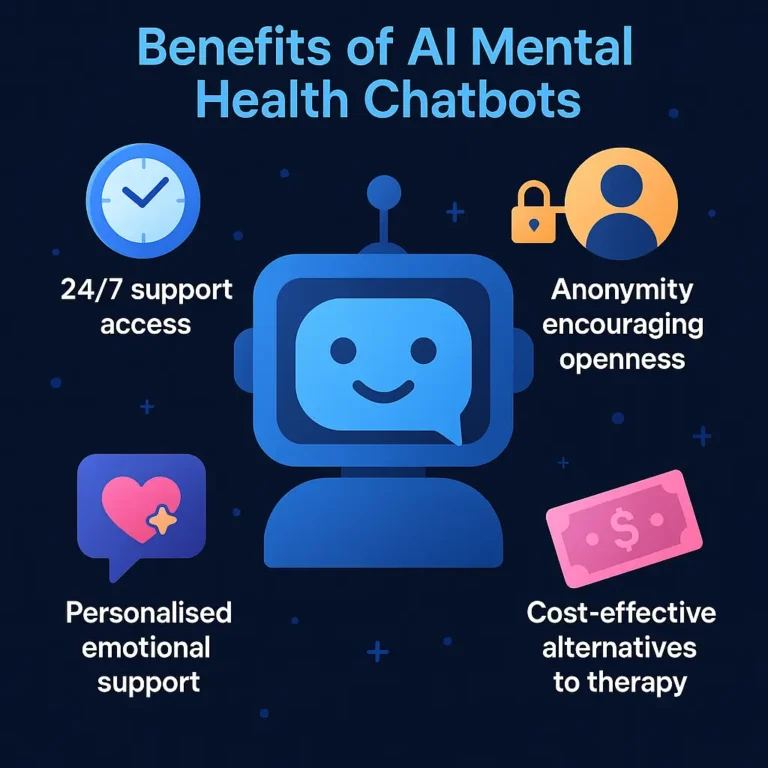
For Users:
AI chatbots bring a range of tangible advantages for individuals seeking mental health support:
24/7 Support Access
Users can connect with AI chatbots anytime, without worrying about clinic hours or appointment slots. This instant availability can be crucial during moments of emotional distress.Anonymity Encouraging Openness
Many users feel more comfortable discussing sensitive issues anonymously with a chatbot, reducing fear of judgment and breaking down barriers to seeking help.Personalised Emotional Support
Modern chatbots use AI-driven insights to adapt conversations based on a user’s emotional state, interaction history, and preferences, creating a highly individualised support experience.Cost-Effective Alternatives to Therapy
Compared to traditional therapy, which can be expensive and often out of reach for many, chatbots offer affordable and often free options for ongoing mental health support.
For Healthcare Providers:
Beyond direct-to-user benefits, AI chatbots also provide critical value to the broader healthcare ecosystem:
Patient Pre-Screening
Chatbots can gather preliminary information, identify symptoms, and assess severity levels, helping healthcare providers triage patients more effectively.Symptom Tracking and Monitoring
Through daily or weekly interactions, chatbots collect valuable longitudinal data, enabling providers to monitor patient progress, spot early warning signs, and adjust interventions accordingly.Bridging Gaps During Waiting Periods
With many patients facing long wait times for professional care, chatbots can offer interim support, helping users manage symptoms and feel connected while they wait for appointments.
Real-World Effectiveness: What the Research Says
Extensive research provides a cautiously optimistic view of AI chatbot effectiveness in mental health support:
Moderate Symptom Reduction
Studies show that chatbot interventions can moderately reduce symptoms of depression and anxiety, particularly over short-term usage periods (6–8 weeks).High User Engagement Improves Outcomes
Users who engage more frequently and consistently with chatbots tend to experience better mental health outcomes, reinforcing the importance of designing engaging user experiences.Most Effective for Mild-to-Moderate Cases
Platforms like Woebot and Wysa have demonstrated promising results, especially for individuals with mild-to-moderate symptoms. However, they are not a substitute for clinical treatment in severe mental health conditions.
⚡ Important Note:
The chatbot’s conversational design, emotional intelligence, and personalisation capabilities greatly influence user outcomes. A poorly designed chatbot can leave users feeling misunderstood or disconnected.
Future Trends: What’s Next?
The future of AI chatbots in mental health is moving towards greater sophistication, integration, and personalisation:
Hyper Personalisation
Future chatbots will tailor their responses based on real-time data from wearables, behaviour patterns, voice tones, and other contextual signals, making support even more relevant to individual needs.Affective Computing
Emotionally intelligent AI will be able to detect and respond to a wider range of human emotions not just based on words, but through tone, pacing, and even facial expressions.Telehealth Integration
Chatbots are increasingly being embedded into broader telehealth platforms, acting as frontline tools for assessment, symptom tracking, psychoeducation, and patient engagement.Predictive Analytics
Advanced AI models will be capable of identifying users at risk of deteriorating mental health, allowing for earlier interventions and more proactive care strategies.VR Therapy Integration
Combining AI chatbots with virtual reality therapy will create immersive, interactive mental health experiences particularly useful for treating conditions like PTSD, phobias, and anxiety disorders.
Challenges, Risks, and Ethical Considerations
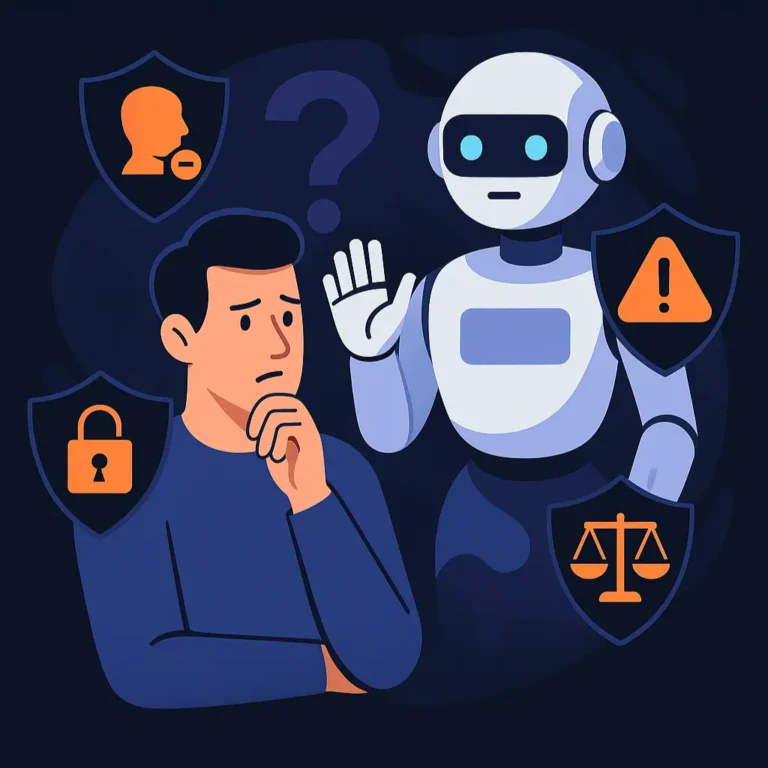
While AI chatbots offer exciting opportunities to transform mental health support, their implementation must be approached thoughtfully and responsibly. Understanding both the technical challenges and the broader ethical considerations is critical to deploying these tools effectively.
Key Technical and Design Challenges:
Despite their exciting potential, AI mental health chatbots come with serious challenges that must be addressed:
- Lack of Genuine Empathy
While chatbots simulate empathy using language patterns, they cannot replicate the deep emotional resonance and understanding offered by human therapists. - Crisis Management Limitations
Most chatbots are not equipped to manage urgent or life threatening mental health crises effectively, making them risky if users rely on them in severe situations. - Data Privacy and Security Concerns:
Mental health conversations involve highly sensitive personal information. Protecting this data requires robust encryption, secure handling practices, and strict regulatory compliance. - Algorithmic Bias
AI models trained on non-representative datasets may underperform or behave inequitably across different cultural, demographic, or linguistic groups, potentially exacerbating existing disparities in mental healthcare.
Navigating the Ethical Landscape
Beyond technical challenges, AI chatbots raise profound ethical questions around user safety, informed consent, and responsible innovation. Mental health tools must uphold the highest standards of trust, transparency, and accountability.
Transparency:
Users must clearly understand what chatbots can and cannot do — including their limitations in diagnosing, treating, or managing mental health conditions.Human Oversight:
AI chatbots must complement, not replace, qualified mental health professionals. Ongoing human supervision is essential, especially for escalating serious concerns.Regulatory Compliance:
In Australia, regulatory bodies such as the TGA (Therapeutic Goods Administration) and Ahpra (Australian Health Practitioner Regulation Agency) set clear guidelines for the ethical use of AI in healthcare. Adherence to these standards is mandatory when designing or deploying mental health technologies.Data Ethics:
Organisations must ensure that the collection, storage, and use of user data are governed by strict privacy laws, informed consent, and user control mechanisms.
ITNEXA: Your Partner in Building Ethical AI Solutions for Workplace Wellbeing
At ITNEXA, we understand that implementing AI-powered solutions isn’t just about technology it’s about applying innovation responsibly.
Our expertise in AI development and cross-platform applications uniquely positions us to help Australian SMBs explore the potential of mental health chatbots with the highest ethical standards.
Here’s how we support you:
Identifying the unique mental health needs of your workforce.
Developing or integrating secure, compliant chatbot solutions.
Implementing appropriate safeguards, human oversight, and user education.
Strategically aligning chatbot support with your existing wellbeing initiatives.
The future of workplace mental health support is evolving and technology will play a pivotal role.
By understanding both the possibilities and limitations of AI chatbots, Australian businesses can foster healthier, more resilient teams while maintaining user trust and regulatory compliance.
📢 Ready to Explore the Future of Workplace Wellbeing?
If you’re ready to responsibly integrate AI chatbots into your mental health initiatives, we’re here to help.

